Fuses are critical components in your 2002 Ford Ranger, safeguarding its electrical system from damage caused by overloads. When electrical issues arise in your vehicle, a blown fuse is often the culprit. Before diving into complex repairs, checking your fuses, especially the one related to your OBD2 port, is a crucial first step. This guide will help you locate and troubleshoot fuses in your 2002 Ford Ranger, with a specific focus on the OBD2 fuse.
Understanding your 2002 Ford Ranger’s fuse system is essential for maintaining your vehicle’s electrical health. Your Ranger utilizes two primary fuse box locations: the passenger compartment fuse panel and the power distribution box in the engine compartment. Each box contains fuses protecting different circuits throughout your vehicle.
Locating the Fuse Boxes in Your 2002 Ford Ranger
Knowing where to find these fuse boxes is the first step in diagnosing any electrical issue.
Passenger Compartment Fuse Panel
The passenger compartment fuse panel in your 2002 Ford Ranger is conveniently located inside the vehicle.
To access it, look to the left end of the instrument panel on the driver’s side. You’ll find a cover that needs to be removed. Typically, you can remove the fuse panel cover by inserting your finger into the provided divot and gently pulling it open. Inside the cover, you might find spare fuses for replacements, and sometimes a fuse pulling tool is located within the panel itself to aid in fuse removal.
This panel houses fuses for various interior electrical components. For your 2002 Ford Ranger, the fuse layout is crucial for identifying the correct fuse for systems like interior lights, radio, and potentially circuits related to the OBD2 port. Let’s examine the fuse chart for this passenger compartment panel:
| No. | AMPS | Protected circuits |
|---|---|---|
| 1 | 5 | Power Mirror Switch |
| 2 | 10 | Daytime Running Lights (DRL), Back-up Lamps, Transmission, Passenger Air Bag Deactivation Switch, Blower Motor Relay |
| 3 | 7.5 | 2001-2002: Right Stop/Turn Trailer Tow Connector 2003: Left Stop/Turn Trailer Tow Connector |
| 4 | — | Not Used |
| 5 | 15 | 4×4 Control Module |
| 6 | 2 | 2002-2003: Brake Pressure Switch |
| 7 | 7.5 | 2001-2002: Left Stop/Turn Trailer Tow Connector 2003: Right Stop/Turn Trailer Tow Connector |
| 8 | — | Not Used |
| 9 | 7.5 | Brake Pedal Position Switch |
| 10 | 7.5 | Speed Control Servo/Amplifier Assembly, Generic Electronic Module (GEM), Shift Lock Actuator, Turn Signals, 4×4 |
| 11 | 7.5 | Instrument Cluster, 4×4, Main Light Switch, Truck Central Security Module (TCSM), GEM |
| 12 | — | Not Used |
| 13 | 20 | Brake Pedal Position Switch |
| 14 | 10 | ABS Control Module |
| 15 | — | Not Used |
| 16 | 30 | Windshield Wiper Motor, Wiper Hi-Lo Relay, Wiper Run/Park Relay |
| 17 | 20 | Cigar Lighter, Data Link Connector (DLC) |
| 18 | — | Not Used |
| 19 | 25 | Powertrain Control Module (PCM) Power Diode, Ignition, PATS |
| 20 | 7.5 | Generic Electronic Module (GEM), Radio |
| 21 | 15 | Flasher (Hazard) |
| 22 | 20 | Auxiliary Power Socket |
| 23 | — | Not Used |
| 24 | 7.5 | Clutch Pedal Position (CPP) switch, Starter Interrupt Relay |
| 25 | — | Not Used |
| 26 | 10 | Battery Saver Relay, Auxiliary Relay Box, Restraint Central Module (RCM), Generic Electroic Module (GEM), Instrument Cluster |
| 27 | — | Not Used |
| 28 | 7.5 | Generic Electronic Module (GEM), Radio |
| 29 | 20 | Radio |
| 30 | — | Not Used |
| 31 | — | Not Used |
| 32 | — | Not Used |
| 33 | 15 | Headlamps, Daytime Running Lamps (DRL) Module, Instrument Cluster |
| 34 | — | Not Used |
| 35 | 15 | Horn Relay if Not Equipped with Truck Central Security Module |
| 36 | — | Not Used |
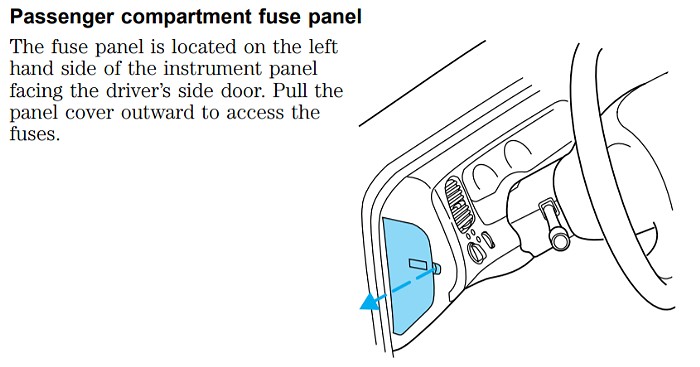
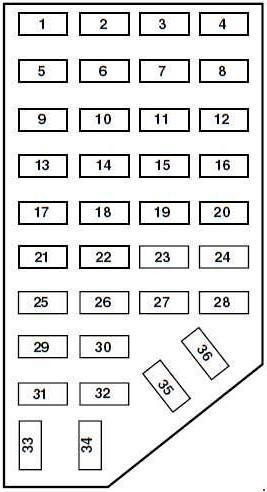
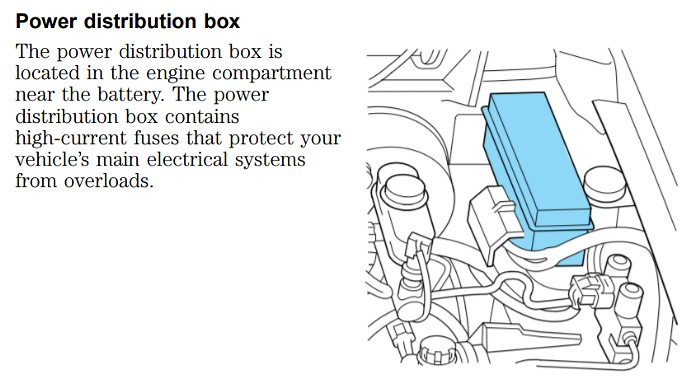
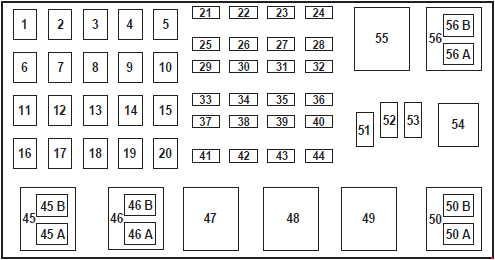
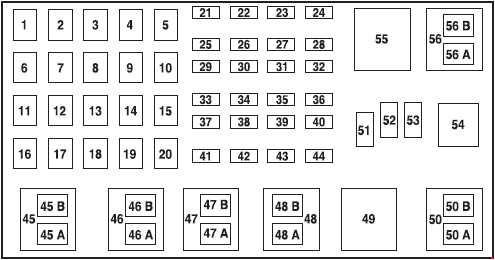
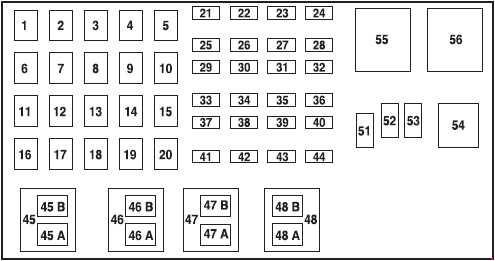


Power Distribution Box
The power distribution box, on the other hand, is located in the engine compartment.
Specifically, you’ll find it on the driver’s side, near the fender. This box typically houses fuses and relays for high-current circuits like the engine controls, exterior lighting, and power windows.
Here’s the fuse chart for the power distribution box in your 2002 Ford Ranger:
| No. | AMP | Protected circuits |
|---|---|---|
| 1 | 50 | I/P Fuse Panel |
| 2 | 50 | Amplifier (Tremor audio system only) |
| 3 | — | Not Used |
| 4 | — | Not Used |
| 5 | — | Not Used |
| 6 | 50 | ABS Pump Motor |
| 7 | 30 | Powertrain Control Module (PCM) |
| 8 | 20 | Power Door Locks and Remote Entry |
| 9 | — | Not Used |
| 10 | — | Not Used |
| 11 | 50 | Starter Relay, Ignition Switch |
| 12 | 20 | Power Windows |
| 13 | 20 | 3.0L and 4.0L engines: 4×4 Motor |
| 14 | — | Not Used |
| 15 | — | Not Used |
| 16 | 40 | Blower Motor |
| 17 | 20 | 2.3L engine: Auxiliary Cooling Fan |
| 18 | — | Not Used |
| 19 | — | Not Used |
| 20 | — | Not Used |
| 21 | 10 | PCM Memory |
| 22 | — | Not Used |
| 23 | 20 | Fuel Pump Motor |
| 24 | 30 | Headlamps |
| 25 | 10 | A/C Clutch Solenoid |
| 26 | — | Not Used |
| 27 | — | Not Used |
| 28 | 30 | 4WABS Module |
| 29 | — | Not Used |
| 30 | 15 | Trailer Tow |
| 31 | 20 | Foglamps, Daytime Running Lamps (DRL) |
| 32 | — | Not Used |
| 33 | 15 | Park Lamp |
| 34 | — | Not Used |
| 35 | — | Not Used |
| 36 | — | Not Used |
| 37 | — | Not Used |
| 38 | 10 | Left Headlamp Low Beam |
| 39 | — | Not Used |
| 40 | — | Not Used |
| 41 | 20 | Heated Oxygen Sensors |
| 42 | 10 | Right Headlamp Low Beam |
| 43 | — | 2.3L engine: (Resistor) |
| 44 | — | Not Used |
| 51 | — | Not Used |
| 52 | — | Not Used |
| 53 | — | Diode: Powertrain Control Module (PCM) |
| Relay | ||
| 45A | Wiper HI/LO | |
| 45B | Wiper Park/Rim | |
| 46A | 2.3L engine: Fuel Pump 3.0L and 4.0L engines (2002-2003): Fuel Pump | |
| 46B | 2.3L engine: Trailer Tow 3.0L and 4.0L engines (2001): Front Washer Pump 3.0L and 4.0L engines (2002-2003): Trailer tow | |
| 47 | 2.3L engine: Starter 3.0L and 4.0L engines (2001): A/B – Not Used | |
| 47A | 3.0L and 4.0L engines (2002-2003): A/C clutch solenoid | |
| 47B | 3.0L and 4.0L engines (2002-2003): Front washer pump | |
| 48 | 2.3L engine: Auxiliary Cooling Fan | |
| 48A | 3.0L and 4.0L engines: Fog Lamps | |
| 48B | 3.0L and 4.0L engines: Fog Lamp Relay | |
| 49 | 3.0L and 4.0L engines (2001): Starter | |
| 50 | Not Used | |
| 50A | 3.0L and 4.0L engines (2001): Not Used | |
| 50B | 3.0L and 4.0L engines (2001): Fuel Pump | |
| 54 | Powertrain Control Module (PCM) | |
| 55 | Blower | |
| 56 | 3.0L and 4.0L engines (2002-2003): Starter | |
| 56A | A/C Clutch Solenoid | |
| 56B | 2.3L engine: Front Washer Pump 3.0L and 4.0L engines (2001): Trailer Tow |
Finding the OBD2 Fuse in Your 2002 Ford Ranger
To pinpoint the fuse for your OBD2 port, we need to look at the fuse charts provided. The OBD2 port, also known as the Data Link Connector (DLC), is essential for diagnostics and connecting scan tools.
Referring to the Passenger Compartment Fuse Panel chart, we can see Fuse #17 (20 AMP) is listed as protecting the “Cigar Lighter, Data Link Connector (DLC)”.
Therefore, for a 2002 Ford Ranger, Fuse #17 in the passenger compartment fuse panel is the fuse you should check if you are experiencing issues with your OBD2 port or cigar lighter. If your OBD2 scanner is not powering up or communicating, this fuse is a prime suspect.
Checking and Replacing Fuses in Your 2002 Ford Ranger
Once you’ve identified the potential OBD2 fuse or any other fuse you suspect is blown, follow these steps to check and replace it:
-
Locate the Fuse Panel: Refer to the locations described earlier for either the passenger compartment fuse panel or the power distribution box.
-
Identify the Fuse: Use the fuse panel diagrams (often found on the inside of the fuse box cover or in your owner’s manual) to locate the specific fuse number you want to check (e.g., #17 for the OBD2 port in the passenger compartment).
-
Inspect the Fuse: Visually inspect the fuse. Most fuses are transparent, allowing you to see the internal wire. If the wire inside is broken or melted, the fuse is blown and needs replacement.
Alternatively, for a more definitive test without removing the fuse, you can use a fuse tester. These testers, like a Bussmann fuse tester, can quickly check fuse continuity. Simply align the tester prongs with the metal contacts on top of the fuse. If the indicator light illuminates, the fuse is good. If not, it’s blown.
- Replace the Fuse (If Blown): If the fuse is blown, remove it. You can often use a fuse pulling tool (if available in your fuse box) or gently pull it out with your fingers.
*WARNING: Always replace a blown fuse with a fuse of the exact same amperage rating. Using a fuse with a higher amperage rating can bypass the circuit protection, potentially causing serious damage to wiring and increasing the risk of fire. Refer to the fuse chart for the correct amperage.
-
Install New Fuse: Push the new fuse firmly into the fuse slot until it is fully seated.
-
Replace Fuse Panel Cover: Reinstall the fuse panel cover securely.
-
Test the Circuit: After replacing the fuse, test the affected electrical component (e.g., try your OBD2 scanner or cigar lighter) to see if it now works.
If the new fuse blows immediately or repeatedly, it indicates an underlying electrical problem in the circuit. In such cases, further diagnosis by a qualified automotive technician is recommended to identify and repair the root cause of the overload.
Fuse Color Codes and Amperage
Fuses are color-coded to easily identify their amperage ratings. This standardization makes it simple to select the correct replacement fuse.
Common fuse colors and their corresponding amperage ratings include:
- Red: 10 Amp
- Light Blue: 15 Amp
- Natural/Clear: 20 Amp
- Light Green: 30 Amp
Always double-check the fuse color and amperage rating against your fuse panel diagram to ensure you are using the correct fuse for replacement.
By understanding the fuse system in your 2002 Ford Ranger, knowing the locations of the fuse boxes, and learning how to check and replace fuses, you can effectively troubleshoot common electrical issues, including problems related to your OBD2 port. Remember to always prioritize safety and use the correct replacement fuses to protect your vehicle’s electrical system. If you encounter persistent issues, consult a professional mechanic for further assistance.